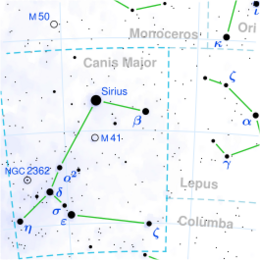Astronomy:Mu Canis Majoris
| Observation data Equinox J2000.0]] (ICRS) | |
|---|---|
| Constellation | Canis Major |
| Right ascension | 06h 56m 06.64589s[1] |
| Declination | −14° 02′ 36.3520″[1] |
| Apparent magnitude (V) | 5.12 (5.27 + 7.32)[2] |
| Characteristics | |
| Spectral type | K2/3 III + B9/A0 V[3] |
| Astrometry | |
| Radial velocity (Rv) | 18.1±0.1[4] km/s |
| Proper motion (μ) | RA: −1.59[1] mas/yr Dec.: + 6.33[1] mas/yr |
| Parallax (π) | 2.62 ± 0.58[1] mas |
| Distance | approx. 1,200 ly (approx. 380 pc) |
| Absolute magnitude (MV) | −2.22[5] |
| Details | |
| μ CMa A | |
| Surface gravity (log g) | 2489[6] cgs |
| Temperature | 4,441[6] K |
| Rotational velocity (v sin i) | ≤ 5[7] km/s |
| μ CMa B | |
| Mass | 14.7±0.3[8] M☉ |
| Age | 11.6±0.5[8] Myr |
| Other designations | |
| μ CMa A: HD 51250[9] | |
| μ CMa B: HD 51251[10] | |
| Database references | |
| SIMBAD | data |
Mu Canis Majoris (μ Canis Majoris) is a binary star[2] system in the southern constellation of Canis Major. The pair can be located a little to the southwest of the point midway between Gamma and Theta Canis Majoris,[11] and the components can be split with a small telescope.[12] The system is faintly visible to the naked eye with an apparent visual magnitude of 5.12.[2] Based upon an annual parallax shift of just 2.62 mas as seen from Earth,[1] this system is located roughly 1,200 light years from the Sun.
Grotius assigned the name Isis to this star, but the name, now obsolete, belonged rather to Gamma Canis Majoris.[13]
As of 2011, the pair had an angular separation of 2.77 arc seconds along a position angle of 343.9°.[14] The orange-hued primary member, component A, is an evolved K-type giant star with a stellar classification of K2/3 III[3] and a visual magnitude of 5.27.[2] The base magnitude 7.32[2] companion, component B, is a hybrid B/A-type main-sequence star with a class of B9/A0 V.[3]
The system has two visual companions. As of 2008, magnitude 10.32 component C lies at an angular separation of 86.90″, while magnitude 10.64 component D is at a separation of 105.0″.[15] Mu CMa should not be confused with the 9th magnitude variable star MU CMa located near NGC 2360.[16]
References
- ↑ 1.0 1.1 1.2 1.3 1.4 1.5 van Leeuwen, F. (2007), "Validation of the new Hipparcos reduction", Astronomy and Astrophysics 474 (2): 653–664, doi:10.1051/0004-6361:20078357, Bibcode: 2007A&A...474..653V.
- ↑ 2.0 2.1 2.2 2.3 2.4 Eggleton, P. P.; Tokovinin, A. A. (September 2008), "A catalogue of multiplicity among bright stellar systems", Monthly Notices of the Royal Astronomical Society 389 (2): 869–879, doi:10.1111/j.1365-2966.2008.13596.x, Bibcode: 2008MNRAS.389..869E.
- ↑ 3.0 3.1 3.2 Houk, Nancy; Smith-Moore, M. (1978), Michigan catalogue of two-dimensional spectral types for the HD stars, 4, Ann Arbor: Dept. of Astronomy, University of Michigan, Bibcode: 1988mcts.book.....H.
- ↑ de Bruijne, J. H. J.; Eilers, A.-C. (October 2012), "Radial velocities for the HIPPARCOS-Gaia Hundred-Thousand-Proper-Motion project", Astronomy & Astrophysics 546: 14, doi:10.1051/0004-6361/201219219, A61, Bibcode: 2012A&A...546A..61D.
- ↑ Ginestet, N.; Carquillat, J. M. (2002), "Spectral Classification of the Hot Components of a Large Sample of Stars with Composite Spectra, and Implication for the Absolute Magnitudes of the Cool Supergiant Components", The Astrophysical Journal Supplement Series 143 (2): 513, doi:10.1086/342942, Bibcode: 2002ApJS..143..513G.
- ↑ 6.0 6.1 McDonald, I. et al. (2012), "Fundamental Parameters and Infrared Excesses of Hipparcos Stars", Monthly Notices of the Royal Astronomical Society 427 (1): 343–57, doi:10.1111/j.1365-2966.2012.21873.x, Bibcode: 2012MNRAS.427..343M.
- ↑ Eaton, J. A. (May 1990), "Rotational Velocities of G and K Giants", Information Bulletin on Variable Stars 3460: 1, Bibcode: 1990IBVS.3460....1E.
- ↑ 8.0 8.1 Tetzlaff, N. et al. (January 2011), "A catalogue of young runaway Hipparcos stars within 3 kpc from the Sun", Monthly Notices of the Royal Astronomical Society 410 (1): 190–200, doi:10.1111/j.1365-2966.2010.17434.x, Bibcode: 2011MNRAS.410..190T.
- ↑ 9.0 9.1 "mu. CMa". SIMBAD. Centre de données astronomiques de Strasbourg. http://simbad.u-strasbg.fr/simbad/sim-basic?Ident=mu.+CMa.
- ↑ "HD 51251". SIMBAD. Centre de données astronomiques de Strasbourg. http://simbad.u-strasbg.fr/simbad/sim-basic?Ident=HD+51251.
- ↑ O'Meara, Steve (2007), Herschel 400 Observing Guide, Cambridge University Press, p. 63, ISBN 978-0521858939, https://books.google.com/books?id=Nyh9fAC_tpIC&pg=PA63.
- ↑ Consolmagno, Guy (2011), Turn Left at Orion: Hundreds of Night Sky Objects to See in a Home Telescope – and How to Find Them, Cambridge, United Kingdom: Cambridge University Press, p. 81, ISBN 978-1-139-50373-0, https://books.google.com/books?id=h3712RgWkOYC&pg=PA80.
- ↑ Richard Hinckley Allen (1963-06-01). Star Names: Their Lore and Meaning. Dover Publications. ISBN 978-0486210797. https://archive.org/details/starnamestheirlo00alle.
- ↑ Mason, Brian D. et al. (May 2012), "Speckle Interferometry at the U.S. Naval Observatory. XVIII", The Astronomical Journal 143 (5): 6, doi:10.1088/0004-6256/143/5/124, 124, Bibcode: 2012AJ....143..124M, https://apps.dtic.mil/sti/pdfs/ADA561759.pdf.
- ↑ Mason, B. D. et al. (2014), "The Washington Visual Double Star Catalog", The Astronomical Journal 122 (6): 3466, doi:10.1086/323920, Bibcode: 2001AJ....122.3466M.
- ↑ "International variable star Index: MU CMa". AAVSO. http://www.aavso.org/vsx/index.php?view=detail.top&oid=5436. Retrieved 2012-06-03.
External links
- Mu Canis Majoris on WikiSky: DSS2, SDSS, GALEX, IRAS, Hydrogen α, X-Ray, Astrophoto, Sky Map, Articles and images
- WikiSky, μ CMa (Isis)
- Alcyone, μ Canis Majoris
 |


